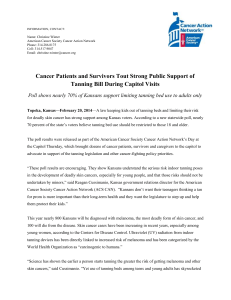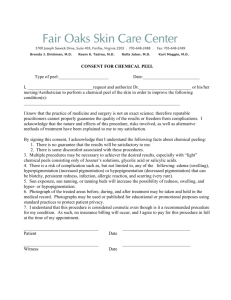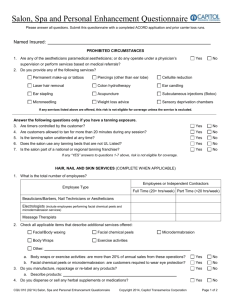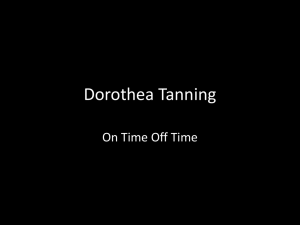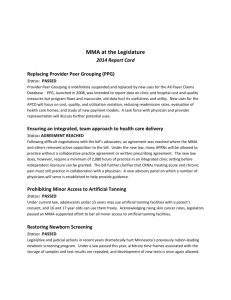essay - 08SajdakM
advertisement
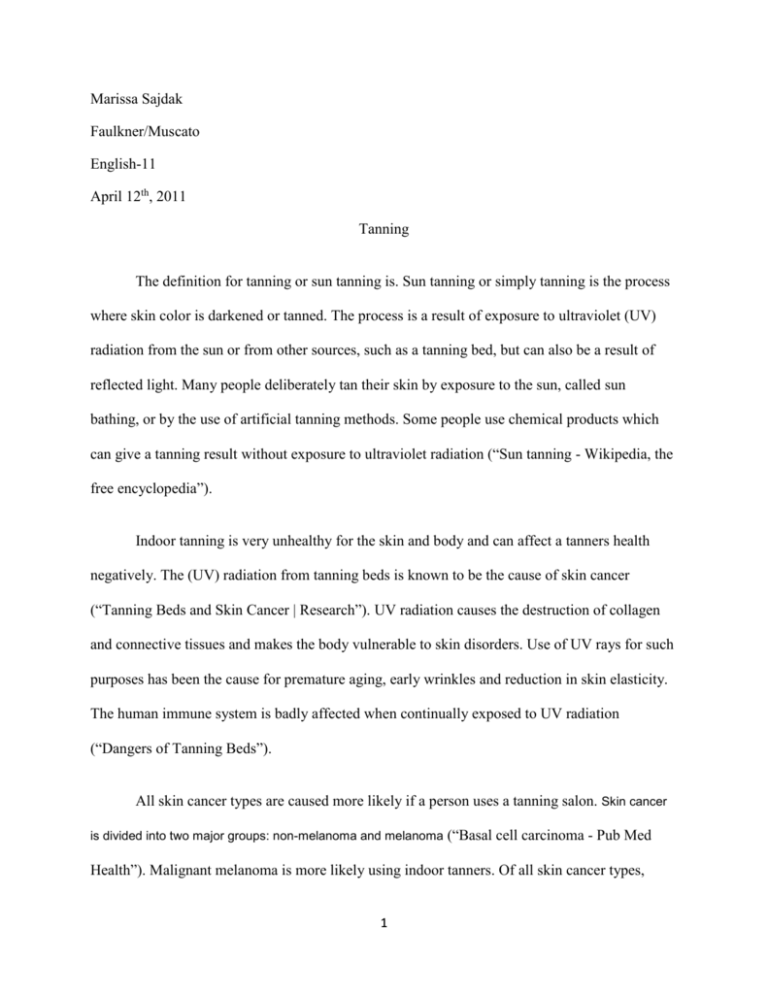
Marissa Sajdak Faulkner/Muscato English-11 April 12th, 2011 Tanning The definition for tanning or sun tanning is. Sun tanning or simply tanning is the process where skin color is darkened or tanned. The process is a result of exposure to ultraviolet (UV) radiation from the sun or from other sources, such as a tanning bed, but can also be a result of reflected light. Many people deliberately tan their skin by exposure to the sun, called sun bathing, or by the use of artificial tanning methods. Some people use chemical products which can give a tanning result without exposure to ultraviolet radiation (“Sun tanning - Wikipedia, the free encyclopedia”). Indoor tanning is very unhealthy for the skin and body and can affect a tanners health negatively. The (UV) radiation from tanning beds is known to be the cause of skin cancer (“Tanning Beds and Skin Cancer | Research”). UV radiation causes the destruction of collagen and connective tissues and makes the body vulnerable to skin disorders. Use of UV rays for such purposes has been the cause for premature aging, early wrinkles and reduction in skin elasticity. The human immune system is badly affected when continually exposed to UV radiation (“Dangers of Tanning Beds”). All skin cancer types are caused more likely if a person uses a tanning salon. Skin cancer is divided into two major groups: non-melanoma and melanoma (“Basal cell carcinoma - Pub Med Health”). Malignant melanoma is more likely using indoor tanners. Of all skin cancer types, 1 malignant melanoma is the deadliest (“Tanning Beds and Skin Cancer | Research”). Malignant melanoma is a malignant tumor of melanocytes. Melanocytes are cells that produce the dark pigment, melanin, which is responsible for the color of skin. It is much more dangerous and causes the majority 75% of deaths related to skin cancer. Worldwide, doctors diagnose about 160,000 new cases of melanoma yearly (“Melanoma - Wikipedia, the free encyclopedia”). Basal cell carcinoma is a type of non-melanoma skin cancer, and is the most common form of cancer in the United States. Almost all basal cell carcinomas occur on parts of the body excessively exposed to the sun. Especially the face, ears, neck, scalp, shoulders, and back. Many people get skin cancer from tanning beds each year, and the amount is increasing. Up to 30 million people tan indoors every year and 2 million of those are teenagers (“The Skin Cancer Foundation - Skin Cancer Facts”). Rates are predicted to go up by a further 70 per cent over the next 15 years as the effects of increased sun bed use (“The Skin Cancer Foundation Skin Cancer Facts”). Many new cases occur every year. Fifty thousand people will be diagnosed with malignant melanoma this year in the United States alone. Many others will have less dangerous forms of skin cancer (“Skin Cancer Research | Research”). More than 1,700 people die from the disease. Melanoma is attacking younger people more often (“Deadly Skin Cancer Risk Soaring Among Young People”). Skin cancer develops mainly on areas of sun-exposed skin. It can also form on areas that rarely see the light of day. The palms, beneath fingernails, the spaces between toes or under your toenails, and the genital area (“Skin cancer: Symptoms - MayoClinic.com”). There are symptoms of skin cancer to look for, and a constant tanner can check themselves. A few symptoms of skin cancer are. An unusually large mole or other pigmented spot on your body. A scar or other 1 2 colorless area that wasn't there before mole or mark with uneven edges, shape or color. A mole that sticks up over the surface of the skin and has a rough or textured surface (“Skin Cancer Facts | Facts”). You should examine your skin every six to eight weeks. Examine all moles or markings and look for any changes in the number, size, shape or color of these markings (“Cancer Research Institute”). Checking out your skin or having your spouse or a relative do it for you can help you catch skin cancer early on. All types of skin cancer are easy to treat in the earliest stages. They can often be completely removed, leave very small scars, and have a low chance of coming back (“Skin Cancer Facts | Facts”). Basal cell carcinomas are less often on the top sides of the arms and hands. Squamous cell carcinomas are more likely than basal cells carcinomas to form on the top of the arms and hands. Malignant melanomas usually form on the area of the body between the neck and the hips or legs. Not all changes in the skin are symptoms of skin cancer (“What Are The Symptoms Of Skin Cancer? | ehealthMD”). Older people are much more likely to get skin cancer than younger ones (“The Skin Cancer Foundation - Skin Cancer Facts”). While older adults are at higher risk for developing skin cancer, skin cancer is rapidly rising in young adults aged 20 to 29, due to the increase in use of tanning beds (“Melanoma Cancer in Young People - The Epidemic of Melanoma Cancer in Young People”). There is a 75% higher risk of melanoma in individuals who started using tanning beds before the age of 35(“Melanoma Cancer in Young People - The Epidemic of Melanoma Cancer in Young People”). Men and women born in 1970 now in their mid-30s are being diagnosed with melanoma. At the same rate as people who were born in 1930 and did not develop melanoma until their 50s (“Deadly Skin Cancer Risk Soaring Among Young People”). 1 3 Depending on a person’s skin type, tanning can be more harmful to others. The U.S. Food and Drug Administration and the American Academy of Dermatology have developed six skin types. Classification into the various skin types is based on two causes. A person's sensitivity to ultraviolet (UV) light from the sun or tanning beds, and the person's skin tone. (“Tanning Effects On Different Skin Types”).The difference between skin types is the amount of melanin produced by the melanocytes (“Tanning Effects On Different Skin Types”). People with white skin, easily burns, and never tans. Sensitive light skin rarely tans, and burns more often. Light skin, tans more, and burns equally. Light dark skin, tans more than it burns. Darker skin, rarely burns, and tans darkly. Dark skin, never burns, and has dark even tans (“Tanning Effects On Different Skin Types”). Albinos, which would be considered skin type I, do not produce any melanin and are, consequently, at great risk for burning and suffering long-term skin damage (“Tanning Effects On Different Skin Types - Tanning With Fair Skin And More”). AfricanAmericans or those of Mediterranean descent are constantly producing a certain amount of melanin and so are less prone to burning (“Tanning Effects On Different Skin Types - Tanning With Fair Skin And More”). Knowing your skin type helps to determine how long you can stay in the tanning bed (“Tanning Effects On Different Skin Types - Tanning With Fair Skin And More”). The positive health effects of tanning outweighs the negatives (“Health Effects Of Tanning And Vitamin D”). Indoor tanning provides a measure of control over the tanning process that outdoor tanning does not compare with. UV rays are a source for the body to produce vitamin D. Mature adults at risk for osteoporosis can gain health benefits from limited tanning. Vitamin D is necessary for absorbing calcium to prevent osteoporosis, and is essential for bone health (“Tanning Beds”). Tanning helps the body regulate the hormones serotonin and 1 4 melatonin, which help in healthy sleep cycles. Problems with sleeping are wide spread for mature adults (“Tanning Beds”). Concealing blemishes is a positive effect of tanning. A healthy glow reduces the contrast between red spots and the rest of the entire affected area without causing more problems (“Tanning Beds”). Exposure during childhood may help play a protective role against multiple sclerosis (MS) (“Sun Exposure May Reduce MS”). Exposure to bright light has been found to help lessen some symptoms of Pre Menstrual Syndrome, such as mild depression and mood swings, irritability, physical discomfort, and social withdrawal (“Tanning Benefits: Positive Effects of UV Exposure”). Sunless tanning has been shown to be healthier for the body. indoor tanning products are known to be safer as they don't cause premature aging of the skin and skin cancer(“The Skin Cancer Foundation - Skin Cancer Facts”).The downside to indoor tanning products though is the unnatural tanned appearance with orange spots and streaks that make it very unappealing(“Airbrush Sunless Tanning”). Sunless tanning products, also called self-tanners, can give the skin a tanned look without exposing it to harmful ultraviolet rays (“Sunless tanning”). Sunless tanning products are commonly sold as creams, gels, lotions and sprays that apply to the skin. Professional spray-on tanning also is available at many salons, spas and tanning businesses (“Sunless tanning”). People that may burn easily are better off with sunless tanning (“Health Effects Of Tanning And Vitamin D”). sunless tanning is fast so to get the color wanted instantly. Instead of tanning so many times risking skin damage (“Sunless Tanning to a Healthier and Younger You”). Sunless tanning works by saturating dead skin cells in the epidermis and turning the protein into brown. This will then result to a tanned skin. Sunless tanners also act as a sunscreen thus preventing sun rays from causing skin damage (“Sunless Tanning to a Healthier and Younger You”). 1 5 1 6 http://www.who.int/mediacentre/factsheets/fs287/en/ 1 7
